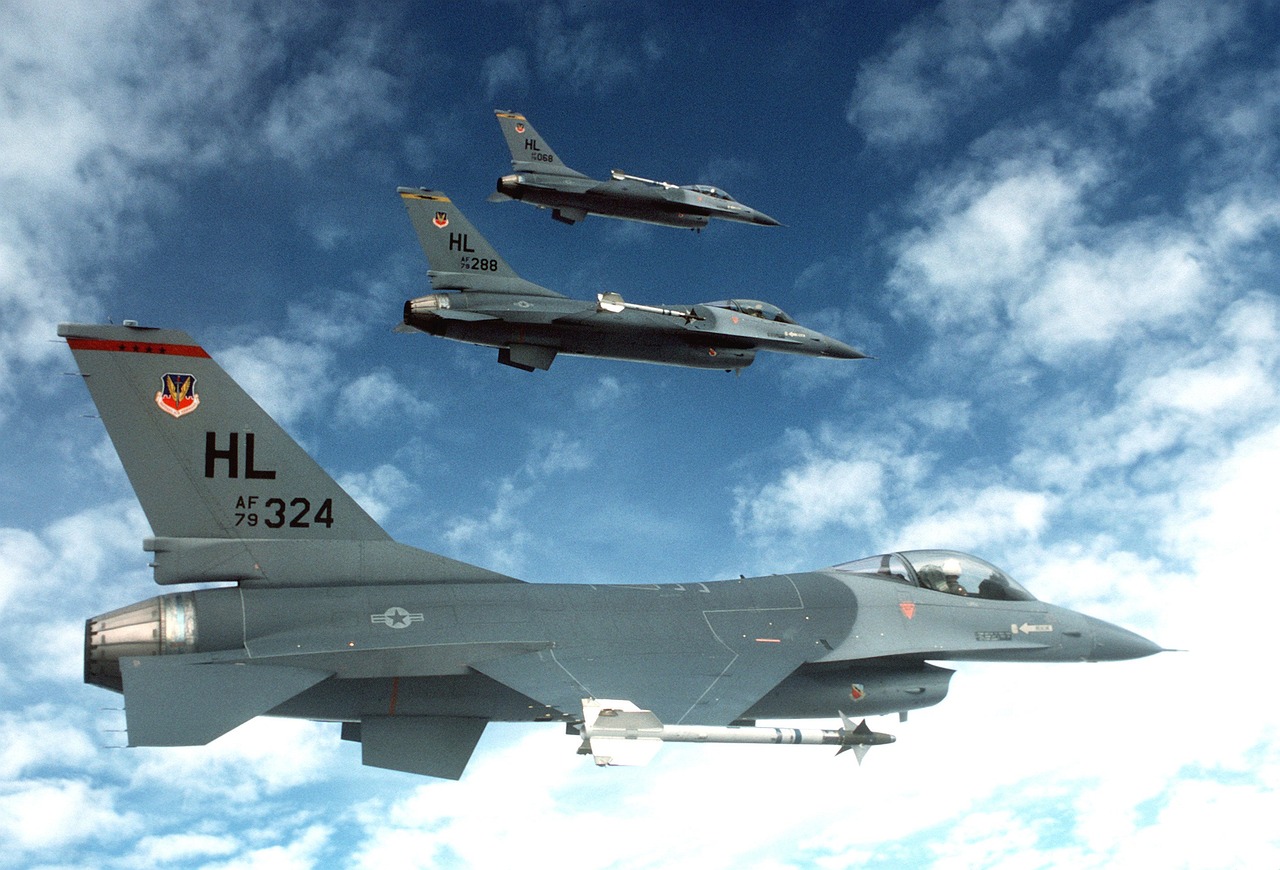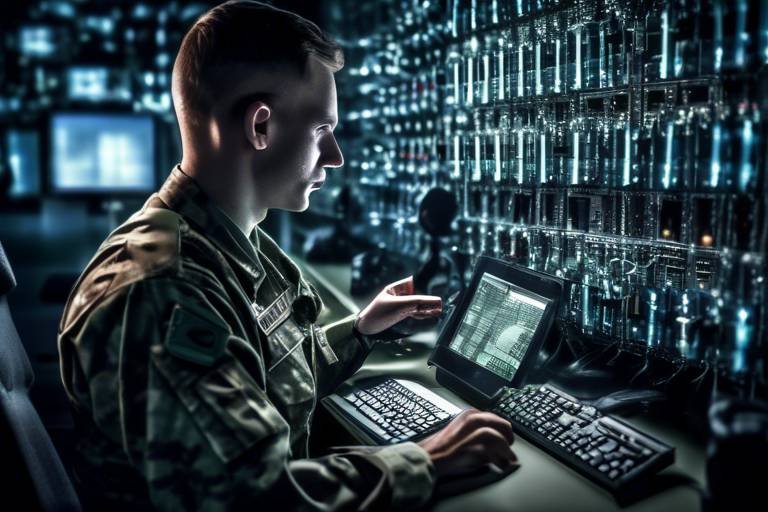Exploring the Potential of AI in Military Data Security
In an age where information is power, the military's data security has never been more critical. Imagine a world where sensitive military information is seamlessly protected from prying eyes and malicious attacks. This is not just wishful thinking; it's becoming a reality thanks to the advancements in artificial intelligence (AI). As we delve into this exciting domain, we will uncover how AI technologies can enhance data security in military applications, examining various strategies, challenges, and future implications. The integration of AI into military data security is akin to adding an impenetrable fortress around vital information, ensuring that only authorized personnel can access it.
AI's potential in military data security is vast and varied. From sophisticated data encryption methods to advanced threat detection systems, AI is reshaping how military organizations protect their sensitive information. But what exactly does this entail? First, let's consider how AI can revolutionize data encryption. Traditional encryption methods, while effective, often struggle to keep pace with the rapidly evolving landscape of cyber threats. AI-driven encryption algorithms can adapt in real-time, learning from new threats and adjusting their protocols accordingly. This adaptability is crucial in a world where cyber adversaries are constantly refining their tactics.
Moreover, AI's role in threat detection cannot be overstated. Imagine having a vigilant guard that never sleeps, tirelessly analyzing patterns and detecting anomalies in military data systems. This is precisely what AI offers. By leveraging machine learning algorithms, AI can sift through vast amounts of data, identifying potential threats before they escalate into serious breaches. The ability to predict and prevent cyberattacks is a game changer for military operations, allowing for a proactive rather than reactive approach to data security.
As we explore the intricacies of AI in military data security, we must also address the challenges that come with its implementation. While the benefits are substantial, integrating AI technologies with existing military frameworks poses significant hurdles. These challenges range from ethical considerations surrounding data privacy to the financial implications of adopting such advanced technologies. It's essential for military organizations to navigate these obstacles carefully to harness the full potential of AI.
Looking forward, the future of AI in military data security appears promising. Innovations are on the horizon, with emerging trends that could further strengthen the security of sensitive military information. As AI technologies continue to evolve, they hold the potential to not only safeguard data but also to enhance overall operational efficiency within military organizations. The journey of integrating AI into military data security is just beginning, and the possibilities are as vast as the data itself.
- What is AI's role in military data security? AI enhances data security through advanced encryption, threat detection, and real-time analysis.
- How does AI improve data encryption methods? AI algorithms adapt to new threats, making encryption more robust and responsive.
- What are the challenges of implementing AI in military contexts? Challenges include ethical concerns, data privacy issues, and resource allocation.
- What is the future outlook for AI in military data security? The future is promising, with innovations expected to enhance security measures and operational efficiency.

The Role of AI in Data Encryption
In today's digital landscape, where information is as valuable as gold, data encryption has become a cornerstone of military data security. With the rise of cyber threats, traditional encryption methods are no longer sufficient to protect sensitive military information. This is where artificial intelligence steps in, revolutionizing the way we think about data protection. AI enhances encryption processes by utilizing advanced algorithms that can adapt and respond to emerging threats dynamically.
Imagine a fortress with walls that can change shape and height depending on the enemy's tactics. That's what AI does for encryption—it creates a dynamic defense system. By analyzing vast amounts of data in real-time, AI can identify vulnerabilities and strengthen encryption protocols accordingly. This adaptability is crucial in military applications, where the stakes are incredibly high, and the cost of a data breach can be catastrophic.
One of the most significant advancements AI brings to data encryption is the ability to employ machine learning algorithms. These algorithms can learn from past data breaches and adapt encryption methods to prevent similar incidents in the future. For instance, if a particular encryption key is compromised, AI can quickly generate a new key and implement it across the system without human intervention. This level of responsiveness is vital for military operations, where every second counts.
Furthermore, AI can enhance encryption through predictive analytics. By analyzing patterns in data access and usage, AI can predict potential threats before they materialize. This proactive approach allows military organizations to stay one step ahead of adversaries, ensuring that sensitive information remains secure. In fact, a study showed that AI-driven encryption methods could reduce the risk of data breaches by up to 30% compared to traditional methods.
However, it's essential to recognize that the integration of AI in data encryption is not without its challenges. For example, the complexity of AI algorithms can sometimes lead to unintended consequences, such as false positives in threat detection. This could result in legitimate access being denied or, worse, critical data being locked away during an emergency. Therefore, while AI enhances encryption, it must be implemented with caution and thorough testing.
As we look to the future, the role of AI in data encryption will only become more pronounced. With advancements in quantum computing on the horizon, AI's ability to adapt and evolve will be crucial in developing encryption methods that can withstand even the most sophisticated attacks. The military must invest in AI technologies now to ensure that they are prepared for the challenges of tomorrow.
In summary, the integration of AI into data encryption represents a significant leap forward in military data security. By leveraging advanced algorithms and machine learning, AI can provide a level of protection that traditional methods cannot match. As we continue to explore the potential of AI in this domain, it is clear that the future of data encryption is not just about locking information away but about creating a responsive, intelligent defense system that evolves with the threats it faces.
- How does AI improve encryption methods? AI enhances encryption by utilizing advanced algorithms that adapt to emerging threats, making data protection more dynamic and responsive.
- What are the risks associated with AI in data encryption? While AI can significantly improve encryption, it can also lead to false positives and unintended consequences if not implemented carefully.
- Can AI predict data breaches? Yes, AI can analyze patterns in data access and usage to predict potential threats before they occur, allowing for proactive security measures.
- Is AI the future of data encryption? Absolutely! As technology evolves, AI will play an increasingly critical role in developing robust encryption methods to safeguard sensitive information.

AI-Driven Threat Detection
In today's digital battlefield, where cyber threats are as prevalent as physical confrontations, artificial intelligence emerges as a game-changer in military data security. AI-driven threat detection systems are not just a technological upgrade; they represent a fundamental shift in how military organizations approach cybersecurity. By leveraging advanced algorithms, AI can sift through vast amounts of data in real-time, identifying patterns and anomalies that might go unnoticed by human analysts. This capability is crucial for preventing cyberattacks and protecting sensitive military information.
Imagine a scenario where a military data system is under constant surveillance by AI. The system is designed to learn from previous attacks, adapting its algorithms to recognize the telltale signs of a potential breach. This proactive approach is akin to having a vigilant guard dog that not only alerts you to intruders but also learns their methods over time, becoming more effective with every encounter. AI can analyze data from various sources, including network traffic, user behavior, and historical attack patterns, to create a comprehensive threat profile.
At the heart of AI-driven threat detection are machine learning algorithms. These algorithms are designed to enhance the accuracy of threat identification by continuously learning and evolving. For instance, supervised learning techniques can be employed to train the system using labeled datasets, allowing it to recognize known threats. In contrast, unsupervised learning can help identify new, previously unknown threats by analyzing data without predefined labels. This dual approach ensures that military data systems remain resilient against both established and emerging threats.
Understanding the difference between supervised and unsupervised learning is vital for implementing AI in military data security. Supervised learning relies on historical data that has been labeled, making it easier for the system to identify specific threats based on past occurrences. However, this method requires a substantial amount of data to be effective. On the other hand, unsupervised learning does not require labeled data, allowing the system to discover patterns and anomalies on its own. While this approach can uncover hidden threats, it may also lead to false positives, necessitating a careful balance between the two methods.
One of the standout features of AI in threat detection is its ability to perform real-time data analysis. In military operations, where every second counts, the capacity to detect and respond to threats instantly can make all the difference. AI systems can monitor network traffic, user activities, and system logs continuously, flagging any irregularities that may indicate a security breach. This immediate response capability is akin to having a fire alarm that not only detects smoke but also alerts the fire department simultaneously, ensuring that potential disasters are mitigated before they escalate.
For AI-driven threat detection to be truly effective, it must be integrated seamlessly with existing military data security frameworks. This integration poses its own set of challenges, as military organizations often rely on legacy systems that may not be compatible with modern AI technologies. However, with the right strategies in place, such as phased implementation and thorough training for personnel, military organizations can harness the full potential of AI to bolster their data security efforts.
- What is AI-driven threat detection?
AI-driven threat detection refers to the use of artificial intelligence technologies to identify and respond to potential cybersecurity threats in real-time. - How does machine learning enhance threat detection?
Machine learning algorithms allow systems to learn from historical data, improving their ability to recognize both known and unknown threats over time. - What are the challenges of integrating AI into existing military systems?
Challenges include compatibility with legacy systems, resource allocation, and the need for personnel training to effectively utilize new technologies.

Machine Learning Algorithms
This article delves into how artificial intelligence can enhance data security in military applications, examining various strategies, challenges, and future implications of AI technologies in safeguarding sensitive information.
AI is revolutionizing data encryption methods, providing advanced algorithms that enhance security measures. This section explores how AI can improve encryption processes to protect military data from unauthorized access.
Artificial intelligence plays a crucial role in identifying potential threats in military data systems. This section discusses how AI can analyze patterns and detect anomalies to prevent cyberattacks and data breaches.
Machine learning algorithms are the backbone of modern threat detection systems, especially in the context of military data security. By leveraging vast amounts of data, these algorithms can identify patterns that may elude human analysts. Imagine sifting through mountains of intelligence reports, communications, and operational data—something that would take humans an eternity to analyze. With AI, this process becomes not only faster but also more accurate.
Different types of machine learning techniques enhance the accuracy of threat identification in military environments. For instance, supervised learning uses labeled datasets to train models, allowing them to predict outcomes based on historical data. This method is particularly effective in scenarios where past incidents can inform future security measures. On the flip side, unsupervised learning does not require labeled data. Instead, it identifies hidden patterns or groupings within the data, making it a powerful tool for discovering unknown threats.
To illustrate the differences, consider the following table:
| Type of Learning | Description | Use Case |
|---|---|---|
| Supervised Learning | Utilizes labeled data to train models. | Identifying known threats based on historical data. |
| Unsupervised Learning | Finds patterns in unlabeled data. | Discovering new, unknown threats. |
Moreover, real-time data analysis is a game-changer in military data security. AI algorithms can process and analyze incoming data streams instantly, enabling immediate responses to potential threats. This speed is crucial in military operations, where every second counts. The ability to detect anomalies in real-time can mean the difference between thwarting a cyberattack and suffering a significant breach.
As military organizations continue to integrate these machine learning algorithms into their data security frameworks, the potential for enhanced protection grows exponentially. However, it’s essential to remain vigilant. The effectiveness of these algorithms hinges on the quality of the data fed into them. Garbage in, garbage out, as they say. Thus, ensuring high-quality, relevant data is paramount for achieving the desired security outcomes.
Integrating AI technologies with current military data security frameworks is crucial for maximizing their effectiveness. This section examines the challenges and strategies for successful integration.
While AI presents significant advantages, there are also challenges to its implementation in military data security. This section highlights potential obstacles, including ethical considerations and technical limitations.
Data privacy is a critical issue when implementing AI in military contexts. This subsection discusses the implications of AI on personal and sensitive data privacy, emphasizing the need for stringent regulations.
Implementing AI technologies can be resource-intensive. This part analyzes the financial and logistical challenges faced by military organizations in adopting AI solutions for data security.
Looking ahead, the future of AI in military data security appears promising. This section speculates on upcoming trends, innovations, and the potential evolution of AI technologies in safeguarding military information.
- What are machine learning algorithms? Machine learning algorithms are computational methods that allow software applications to become more accurate in predicting outcomes without being explicitly programmed to do so.
- How does AI enhance military data security? AI enhances military data security by automating threat detection, improving data encryption, and enabling real-time analysis of potential threats.
- What are the challenges of implementing AI in military security? Key challenges include data privacy concerns, resource allocation, and the need for high-quality data to train machine learning models effectively.

Supervised vs. Unsupervised Learning
When it comes to implementing artificial intelligence in military data security, understanding the distinctions between supervised and unsupervised learning is crucial. These two approaches to machine learning serve different purposes and can significantly impact the effectiveness of threat detection systems. In supervised learning, algorithms are trained on a labeled dataset, which means that the input data is paired with the correct output. This method allows the AI to learn from historical data, making it adept at identifying known threats by recognizing patterns and correlations. For instance, if a military organization has a dataset of previous cyberattacks, supervised learning can help predict future attacks based on similar characteristics.
On the other hand, unsupervised learning does not rely on labeled data. Instead, it analyzes input data without predefined outcomes. This approach is particularly useful for discovering hidden patterns or anomalies that were not previously identified. In a military context, unsupervised learning can help detect unusual behavior in data systems that might indicate a potential security breach, even if that specific threat has never been encountered before. Imagine it as a detective who can spot suspicious activity in a crowd without having a list of known criminals; they rely on instinct and observation.
Both methods have their strengths and weaknesses, and the choice between them often depends on the specific security needs of the military organization:
| Feature | Supervised Learning | Unsupervised Learning |
|---|---|---|
| Data Requirement | Labeled data | Unlabeled data |
| Outcome | Predictive | Descriptive |
| Use Cases | Identifying known threats | Discovering unknown threats |
| Complexity | Generally simpler to implement | Can be more complex due to lack of labels |
In summary, both supervised and unsupervised learning play pivotal roles in enhancing military data security. By leveraging the strengths of each approach, military organizations can create a more robust defense against cyber threats. The combination of both methods allows for a comprehensive security strategy that not only predicts known threats but also uncovers new vulnerabilities that may have gone unnoticed. As AI continues to evolve, understanding these differences will be essential for military leaders aiming to safeguard sensitive information effectively.
- What is supervised learning? Supervised learning is a type of machine learning where the model is trained using labeled data to predict outcomes based on input features.
- What is unsupervised learning? Unsupervised learning involves training a model on data without labeled outcomes, allowing it to find patterns and groupings on its own.
- How does each method apply to military data security? Supervised learning is useful for identifying known threats, while unsupervised learning helps discover new, previously unknown threats.
- Can both methods be used together? Yes, combining both supervised and unsupervised learning can enhance the overall effectiveness of military data security systems.

Real-time Data Analysis
In today's fast-paced military landscape, the ability to conduct is not just a luxury; it's a necessity. Imagine a battlefield where every second counts, and decisions must be made on the fly. AI technologies enable military personnel to analyze vast amounts of data in real-time, allowing them to respond to threats almost instantaneously. This capability transforms how military operations are conducted, shifting from reactive to proactive strategies.
Real-time data analysis involves processing information as it becomes available, rather than waiting for it to be collected and analyzed later. This immediacy is crucial when dealing with potential security threats. For example, AI systems can monitor network traffic and detect unusual patterns that may indicate a cyberattack. By identifying these anomalies in real-time, military organizations can initiate defensive measures before any damage occurs.
Moreover, the integration of machine learning algorithms enhances the effectiveness of real-time analysis. These algorithms continuously learn from incoming data, improving their accuracy and efficiency over time. This means that the more data the system processes, the better it becomes at identifying threats and predicting potential risks. For instance, if a certain pattern of behavior is recognized as suspicious, the AI can flag it for immediate review, allowing human operators to investigate further.
To illustrate the impact of real-time data analysis, consider the following table that outlines key advantages:
| Advantage | Description |
|---|---|
| Immediate Threat Response | Allows for instant action against potential threats, minimizing damage. |
| Enhanced Decision-Making | Provides military leaders with timely insights to make informed decisions. |
| Increased Operational Efficiency | Streamlines processes by automating data analysis and threat detection. |
| Adaptive Learning | Machine learning algorithms improve over time, increasing threat detection accuracy. |
However, implementing real-time data analysis is not without its challenges. The sheer volume of data generated in military operations can be overwhelming. AI systems must be equipped to handle this influx of information without sacrificing speed or accuracy. Additionally, there is always the risk of false positives, where benign activities are mistakenly flagged as threats. To mitigate these risks, military organizations need to invest in robust AI systems and ensure they are regularly updated and maintained.
In conclusion, the power of real-time data analysis in military settings cannot be overstated. It represents a significant leap forward in how military forces can protect sensitive information and respond to threats. As AI technology continues to evolve, we can expect even more sophisticated tools that will further enhance the capabilities of military data security.
- What is real-time data analysis? Real-time data analysis refers to the immediate processing of data as it is generated, allowing for instant insights and actions.
- How does AI improve real-time data analysis in military applications? AI enhances real-time data analysis by automating the detection of anomalies and threats, learning from data patterns, and providing timely insights to decision-makers.
- What are the challenges of implementing real-time data analysis? Challenges include managing large volumes of data, ensuring accuracy, and minimizing false positives in threat detection.
- Why is real-time data analysis important in military operations? It allows military forces to respond quickly to threats, enhancing operational efficiency and decision-making processes.

Integration with Existing Systems
Integrating artificial intelligence (AI) technologies into existing military data security frameworks is not just a technical challenge; it's a strategic necessity. As military organizations strive to enhance their cybersecurity measures, the question arises: how can they effectively incorporate advanced AI solutions without disrupting their current systems? The answer lies in a careful assessment of the existing infrastructure and a well-planned integration strategy.
First and foremost, it's essential to conduct a thorough audit of the current security systems in place. This audit should focus on identifying vulnerabilities and understanding how AI can address these gaps. For instance, if a military organization relies heavily on traditional firewall systems, integrating AI-driven threat detection can significantly bolster their defenses. However, this integration must be seamless to avoid creating additional points of failure or confusion among personnel.
Moreover, training is a critical component of successful integration. Military staff must be equipped with the knowledge and skills to utilize AI tools effectively. This involves not only technical training but also fostering a culture that embraces innovation. After all, the best technology is only as good as the people who operate it. Regular workshops and hands-on training sessions can help bridge the gap between existing knowledge and new AI capabilities.
Another aspect to consider is interoperability. AI systems need to communicate effectively with legacy systems, which can often be a daunting task. To facilitate this, organizations can adopt a modular approach to integration. By implementing AI solutions as standalone modules that can interface with existing systems, military organizations can enhance their security posture without overhauling their entire infrastructure. This method not only mitigates risks but also allows for gradual adoption, which can be less intimidating for personnel.
Additionally, it's crucial to address potential resistance to change. Change is often met with skepticism, especially in traditional military environments. To counter this, leadership must actively promote the benefits of AI integration, highlighting successful case studies and demonstrating tangible improvements in data security. Clear communication regarding the objectives of the integration process can help alleviate fears and foster a more accepting atmosphere.
In conclusion, while the integration of AI technologies into existing military data security systems presents challenges, it also offers unparalleled opportunities for enhancement. By conducting thorough audits, investing in training, ensuring interoperability, and promoting a culture of acceptance, military organizations can successfully navigate the complexities of AI integration. The result? A robust, adaptive security framework that is well-equipped to handle the evolving landscape of cyber threats.
- What are the main benefits of integrating AI into military data security?
Integrating AI can enhance threat detection, improve response times, and automate routine tasks, ultimately leading to a more secure environment. - How can military organizations ensure a smooth integration process?
By conducting audits, providing training, and fostering a culture that embraces change, organizations can facilitate a smoother transition to AI technologies. - What challenges might arise during the integration of AI?
Challenges include resistance to change, interoperability issues with legacy systems, and the need for significant training and resource allocation. - Is AI implementation cost-effective for military organizations?
While initial costs may be high, the long-term benefits of enhanced security and efficiency often outweigh these expenses.

Challenges of Implementing AI in Military Security
Implementing artificial intelligence (AI) in military security is not without its hurdles. While the potential benefits are enormous, there are significant challenges that military organizations must navigate to fully leverage AI technologies. One of the primary obstacles is the intricate nature of military operations, which often require a balance between security and operational efficiency. This balance can be disrupted by the integration of new technologies, leading to potential vulnerabilities.
Another major challenge is the ethical implications surrounding AI use in military contexts. The deployment of AI raises questions about accountability and decision-making, particularly in scenarios where AI might make critical decisions without human intervention. This leads to a pressing need for clear regulations and guidelines to govern the use of AI in military operations. Ethical considerations are paramount, as the misuse of AI could result in unintended consequences that might jeopardize national security.
Moreover, there are technical limitations associated with AI technology. For instance, AI systems require vast amounts of data to function effectively, which can be a double-edged sword. While data is essential for training AI models, the military often deals with sensitive and classified information that must be safeguarded. This creates a dilemma: how can military organizations collect the necessary data without compromising security? Additionally, the complexity of AI systems can lead to difficulties in ensuring their reliability and accuracy, which are critical in high-stakes military environments.
Resource allocation is yet another challenge. Implementing AI technologies can be resource-intensive, requiring significant financial investment and skilled personnel. Military organizations may face budget constraints that limit their ability to adopt advanced AI solutions. Furthermore, the logistics of training personnel to operate and maintain these systems can be daunting. It’s not just about acquiring the technology; it’s about ensuring that the right people are in place to use it effectively.
To better understand the challenges faced, consider the following table that outlines key obstacles and potential solutions:
| Challenge | Potential Solution |
|---|---|
| Ethical Implications | Develop comprehensive regulations and guidelines for AI use. |
| Technical Limitations | Invest in data security measures and improve AI training methodologies. |
| Resource Allocation | Prioritize funding and create training programs for personnel. |
In conclusion, while the integration of AI in military security holds tremendous promise, it is accompanied by a series of formidable challenges that must be addressed. By acknowledging these obstacles and actively seeking solutions, military organizations can pave the way for a future where AI enhances their capabilities without compromising security or ethical standards.
- What are the main challenges of implementing AI in military security? The main challenges include ethical implications, technical limitations, and resource allocation issues.
- How can military organizations address ethical concerns related to AI? By developing comprehensive regulations and guidelines that govern AI use in military contexts.
- Is data security a concern when using AI in military applications? Yes, data security is crucial, as military organizations often handle sensitive and classified information.
- What resources are needed to implement AI effectively? Significant financial investment, skilled personnel, and robust training programs are essential for effective AI implementation.

Data Privacy Concerns
When it comes to the implementation of AI in military data security, one of the most pressing issues revolves around data privacy. In the age of rapid technological advancement, safeguarding sensitive information has never been more critical. The integration of AI systems into military operations raises significant questions about how personal and classified data is handled, stored, and protected. With AI's ability to process vast amounts of data, the risk of exposing sensitive information inadvertently becomes a serious concern.
Imagine a scenario where AI systems are used to analyze communication patterns among military personnel. While this can enhance operational efficiency, it also opens the door to potential misuse of personal data. The challenge lies in balancing the benefits of AI-driven insights with the imperative to maintain the privacy of individuals involved. Military organizations must navigate a fine line between operational effectiveness and ethical responsibility.
Moreover, there are several key factors that amplify these data privacy concerns:
- Data Collection Practices: The sheer volume of data collected for AI analysis can lead to unintended consequences. If not properly regulated, this data can include sensitive personal information that, if leaked, could compromise national security and individual privacy.
- Regulatory Compliance: Military organizations must adhere to stringent regulations regarding data protection. Failing to comply with these regulations can not only result in legal ramifications but also damage public trust.
- Potential for Data Breaches: As AI systems become more sophisticated, they may also attract malicious actors. A successful breach could lead to catastrophic consequences, exposing sensitive military strategies and personal information.
To mitigate these concerns, it is crucial for military organizations to implement robust data governance frameworks. This includes establishing clear policies regarding data usage, ensuring transparency in data collection, and regularly auditing AI systems for compliance with privacy standards. Furthermore, ongoing training for personnel on the importance of data privacy can foster a culture of responsibility and vigilance.
In conclusion, while AI holds the potential to revolutionize military data security, it is imperative that data privacy remains at the forefront of these advancements. By proactively addressing these concerns, military organizations can harness the power of AI while safeguarding the sensitive information that is vital to national security.
- What are the main data privacy concerns associated with AI in military applications?
Data privacy concerns primarily include the potential misuse of personal data, compliance with regulations, and the risk of data breaches. - How can military organizations ensure data privacy when using AI technologies?
By implementing robust data governance frameworks, establishing clear data usage policies, and conducting regular audits of AI systems. - What role does regulation play in AI data privacy?
Regulations help ensure that military organizations adhere to standards that protect sensitive information from misuse and breaches.

Resource Allocation and Costs
Implementing artificial intelligence (AI) technologies in military data security is not just about innovation; it’s also a matter of significant resource allocation and associated costs. The military sector, known for its stringent budgets and resource management, faces unique challenges when integrating AI solutions. The financial implications can be staggering, encompassing everything from initial investment in technology to ongoing maintenance and training costs.
One of the primary concerns is the initial investment. Developing or purchasing AI-driven security systems often requires substantial capital. This includes costs for advanced hardware, specialized software, and the infrastructure needed to support these technologies. For instance, a single AI system can cost millions of dollars to deploy, depending on its complexity and the scale of the military operation it supports. Moreover, the ongoing costs related to updates and cybersecurity measures can further strain budgets.
In addition to financial considerations, there are also human resources to think about. The military must train personnel to operate these sophisticated systems effectively. This training is essential, as the success of AI in data security hinges on having skilled operators who can interpret AI outputs and make informed decisions. The time and resources spent on training can be significant, often requiring the military to divert personnel from other critical tasks.
Furthermore, there is a question of long-term sustainability. As technology evolves, military organizations must continually adapt their AI systems to keep pace with emerging threats and advancements. This may involve additional costs for upgrades and replacements. It’s crucial for military planners to consider not just the immediate expenses but also the long-term financial commitments associated with AI technologies.
To summarize, the resource allocation and costs of implementing AI in military data security can be daunting. However, the potential benefits—enhanced security, improved threat detection, and more efficient data management—often outweigh these challenges. As military organizations navigate this landscape, a strategic approach to budgeting and resource management will be essential to maximize the effectiveness of AI technologies.
- What are the main costs associated with implementing AI in military data security?
The main costs include initial investment in technology, ongoing maintenance, training personnel, and long-term sustainability costs for upgrades and replacements. - How can military organizations manage the costs of AI implementation?
By developing a strategic budget plan, prioritizing essential technologies, and investing in training programs, military organizations can effectively manage costs. - What impact does AI have on military personnel training?
AI implementation requires specialized training for personnel to operate and interpret AI systems, which can divert resources from other critical tasks.

The Future of AI in Military Data Security
The future of AI in military data security is not just bright; it's practically glowing with potential. As we stand on the brink of technological advancements, the military sector is poised to leverage artificial intelligence in ways that were once the stuff of science fiction. Imagine a world where sensitive data is not only protected but is also constantly monitored and analyzed by intelligent systems that learn and adapt in real-time. This is not just a possibility; it’s becoming a reality.
One of the most exciting aspects of AI in military data security is its ability to predict and preempt threats. With the integration of advanced machine learning algorithms, military systems can analyze vast amounts of data to identify patterns that may indicate a potential security breach. This proactive approach means that instead of waiting for an attack to occur, military organizations can take action before the threat materializes. It’s like having a crystal ball that not only sees the future but also provides actionable insights to mitigate risks.
Moreover, the incorporation of AI-driven automation will streamline operations, making data security processes faster and more efficient. For instance, routine security checks that once took hours can now be completed in a fraction of the time, allowing personnel to focus on more strategic tasks. This efficiency gain is crucial, especially in high-stakes environments where every second counts. The military can deploy its resources more effectively, ensuring that human oversight is maintained while allowing AI to handle the heavy lifting.
However, with great power comes great responsibility. The future of AI in military data security will also necessitate a robust framework for ethical considerations and regulatory compliance. As AI systems become more autonomous, questions surrounding accountability and decision-making processes will arise. Who is responsible if an AI system misinterprets data and leads to a security breach? These are critical questions that military organizations must address as they move forward with AI integration.
Additionally, the collaboration between AI and human operators will be essential. While AI can process data at lightning speed, the nuanced understanding and judgment of human operators cannot be overlooked. The future will likely see a hybrid model where AI tools assist military personnel in making informed decisions, blending the accuracy of machine learning with the intuition of human experience. This collaboration can create a more resilient defense against cyber threats.
As we look to the future, training and development will play a pivotal role in ensuring that military personnel are equipped to work alongside AI technologies. Continuous education on AI advancements and cybersecurity measures will be crucial in maintaining an edge over potential adversaries. Military organizations must invest in training programs that not only teach the technical aspects of AI but also foster a culture of innovation and adaptability.
In conclusion, the future of AI in military data security is filled with opportunities and challenges. As technology evolves, so too will the strategies and frameworks that govern its use. By embracing AI, the military can enhance its data security measures, ensuring that sensitive information remains protected in an increasingly complex digital landscape. The potential is enormous, and the journey is just beginning.
- What are the main benefits of using AI in military data security?
AI enhances threat detection, automates routine tasks, and provides predictive analytics to preempt security breaches. - How does AI improve data encryption?
AI can develop advanced algorithms that adapt to new threats, making encryption methods more robust against unauthorized access. - What challenges does AI face in military applications?
Challenges include ethical considerations, data privacy concerns, and the need for significant resource allocation. - Will AI replace human personnel in military data security?
No, AI is expected to complement human roles, enhancing decision-making rather than replacing it.
Frequently Asked Questions
-
How does AI enhance military data encryption?
AI enhances military data encryption by utilizing advanced algorithms that adapt and evolve to counteract emerging threats. These algorithms can analyze vast amounts of data quickly, allowing for more robust encryption methods that protect sensitive information from unauthorized access. Imagine a digital lock that not only secures your data but also learns from attempts to breach it, making it stronger each time!
-
What role does AI play in threat detection?
AI plays a crucial role in threat detection by analyzing patterns and identifying anomalies within military data systems. It acts like a vigilant guard, constantly monitoring for unusual activities that could indicate a cyberattack. By leveraging machine learning techniques, AI can improve its accuracy over time, ensuring that potential threats are detected and mitigated before they escalate.
-
What are the differences between supervised and unsupervised learning in AI?
Supervised learning involves training AI systems on labeled data, where the desired output is known, helping the AI make predictions based on that input. On the other hand, unsupervised learning works with unlabeled data, allowing the AI to identify patterns and group data without prior guidance. Think of supervised learning as teaching a child with flashcards, while unsupervised learning is like letting them explore a new environment and learn on their own.
-
What challenges does AI face in military data security?
AI faces several challenges in military data security, including ethical concerns regarding data privacy and the potential for biased algorithms. Additionally, the implementation of AI can be resource-intensive, requiring significant financial and logistical investments. These obstacles must be carefully navigated to ensure that AI technologies are effectively integrated into existing security frameworks.
-
How can military organizations address data privacy concerns with AI?
To address data privacy concerns, military organizations must establish stringent regulations and guidelines for AI usage. This includes ensuring that personal and sensitive data is handled with the utmost care and transparency. Implementing robust data governance frameworks can help balance the benefits of AI with the need to protect individual privacy rights.
-
What is the future outlook for AI in military data security?
The future of AI in military data security looks promising, with potential advancements in machine learning, real-time data analysis, and integration with existing systems. As technology evolves, we can expect AI to become even more adept at safeguarding sensitive military information, adapting to new threats, and enhancing overall security measures.



















